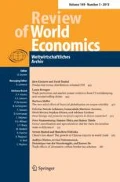Abstract
The present paper serves as an introduction to this special issue providing a justification for, and linking and introducing to the articles that follow. A central message emanating from the papers included in this special issue is that it is not sufficient to double aid efforts by simply raising and transferring more money. Substantial effort needs to be taken in order to delve deeper into the various routes and transmission mechanisms through which the various types of aid operate. And this is a timely as well as important issue in view of recent calls (as well as concerns) for another “big push” approach in development aid.
Similar content being viewed by others
References
Alesina, A., and B. Weder (2002). Do Corrupt Governments Receive Less Foreign Aid? American Economic Review 92 (4): 1126–1137.
Asiedu, E., and B. Nandwa (2007). On the Impact of Foreign Aid in Education on Growth: How Relevant Is the Heterogeneity of Aid Flows and the Heterogeneity of Aid Recipients? Review of World Economics/Weltwirtschaftliches Archiv 143 (4): 631–649.
Berthélemy, J.-C. (2006). Bilateral Donors’ Interest vs. Recipients’ Development Motives in Aid Allocation: Do All Donors Behave the Same? Review of Development Economics 10 (2): 179–194.
Cassen, R. (1986). Does Aid Work? Oxford: Oxford University Press.
Cassen, R. (1994). Does Aid Work? 2nd Edition. Oxford: Oxford University Press.
Cassimon, D., and B. Van Campenhout (2007). Aid Effectiveness, Debt Relief and Public Finance Response: Evidence from a Panel of HIPC Countries. Review of World Economics/Weltwirtschaftliches Archiv 143 (4): 742–763.
CFA (Commission for Africa) (2005). Our Common Interest. Report of the Commission for Africa. Available at <http://www.commissionforafrica.org/english/report/thereport/english/11-03-05_cr_report.pdf>.
Clemens, M., S. Radelet, and R. Bhavnani (2004). Counting Chickens When They Hatch: The Short-Term Effect of Aid on Growth. Center for Global Development Working Paper 44. Washington, D.C.
Cohen, D., P. Jacquet, and H. Reisen (2007). Loans or Grants? Review of World Economics/Weltwirtschaftliches Archiv 143 (4): 764–782.
Cordella, T., and G. Dell’Ariccia (2003). Budget Support versus Project Aid: A Theoretical Appraisal. IMF Working Paper 03/88. International Monetary Fund, Washington, D.C.
Dollar, D., and V. Levin (2006). The Increasing Selectivity of Foreign Aid, 1984–2003. World Development 34 (12): 2034–2046.
Doucouliagos, H., and M. Paldam (2005). The Aid Effectiveness Literature: The Sad Results of 40 Years of Research. Department of Economics Working Paper 2005.05. University of Aarhus.
Fielding, D., and G. Mavrotas (2005). The Volatility of Aid. WIDER Discussion Paper 2005/06. World Institute for Development Economics Research, Helsinki.
Isenman, P., and D. Ehrenpreis (2003). Results of the OECD DAC/Development Centre Experts’ Seminar on “Aid Effectiveness and Selectivity: Integrating Multiple Objectives into Aid Allocations”. DAC Journal 4 (3): 7–25.
Jain, S. (2007). Project Assistance versus Budget Support: An Incentive-Theoretic Analysis of Aid Conditionality. Review of World Economics/Weltwirtschaftliches Archiv 143 (4): 694–719.
Levy, V. (1987). Anticipated Development Assistance, Temporary Relief Aid, and Consumption Behaviour of Low-Income Countries. Economic Journal 97: 446–458.
Mascarenhas, R., and T. Sandler (2006). Do Donors Cooperatively Fund Foreign Aid? Review of International Organizations 1 (4): 337–357.
Mavrotas, G. (2002a). Aid and Growth in India: Some Evidence from Disaggregated Aid Data. South Asia Economic Journal 3 (1): 19–49.
Mavrotas, G. (2002b). Foreign Aid and Fiscal Response: Does Aid Disaggregation Matter? Weltwirtschaftliches Archiv/Review of World Economics 138 (3): 534–559.
Mavrotas, G. (2005). Aid Heterogeneity: Looking at Aid Effectiveness from a Different Angle. Journal of International Development 17 (8): 1019–1036.
Mavrotas, G., and P. Nunnenkamp (2007). Foreign Ais Heterogeneity: Issues and Agenda. Review of World Economics/Weltwirtschaftliches Archiv 143 (4): 585–595.
Mavrotas G., and B. Ouattara (2006). Aid Disaggregation, Endogenous Aid and the Public Sector in Aid-Recipient Economies. Review of Development Economics 10 (3): 434–451.
Mavrotas, G., and B. Ouattara (2007). Aid Modalities and Budgetary Response: Panel Data Evidence. Review of World Economics/Weltwirtschaftliches Archiv 143 (4): 720–741.
McGillivray, M., S. Feeny, N. Hermes, and R. Lensink (2006). It Works; It Doesn’t; It Can, But That Depends. 50 Years of Controversy over the Macroeconomic Impact of Development Aid. Journal of International Development 18 (7): 1031–1050.
Neumayer, E. (2005). Is the Allocation of Food Aid Free from Donor Interest Bias? Journal of Development Studies 41 (3): 394–411.
Ouattara, B. (2006). Aid and Fiscal Policy in Senegal. Journal of International Development 18 (8): 1105–1122.
Pettersson, J. (2007). Child Mortality: Is Aid Fungibility in Pro-Poor Expenditure Sectors Decisive? Review of World Economics/Weltwirtschaftliches Archiv 143 (4): 673–693.
Rajan, R., and Subramanian, A. (2005). Aid and Growth: What Does the Cross-Country Evidence Really Show? IMF Working Paper 05/127. International Monetary Fund, Washington, D.C.
Roodman, D. (2004). An Index of Donor Performance. Center for Global Development Working Paper 42. Washington, D.C.
Singer, H. (1965). External Aid: For Plans or Projects? Economic Journal 75: 539–545.
Svensson, J. (2005). Absorption Capacity and Disbursement Constraints. Paper presented at the Third AFD/EUDN Conference “Financing Development: What Are the Challenges in Expanding Aid Flows?” Paris, December 2005, mimeo.
Thiele, R., P. Nunnenkamp, and A. Dreher (2007). Do Donors Target Aid in Line with the Millennium Development Goals? A Sector Perspective of Aid Allocation. Review of World Economics/Weltwirtschaftliches Archiv 143 (4): 596–630.
UNDP (United Nations Development Programme) (2005). Investing in Development: A Practical Plan to Achieve the Millennium Development Goals, Overview. UN Millennium Project. United Nations, New York.
White, H. (1998). Aid and Macroeconomic Performance: Theory, Empirical Evidence and Four Country Cases. London: Macmillan.
Wolf, S. (2007). Does Aid Improve Public Service Delivery? Review of World Economics/Weltwirtschaftliches Archiv 143 (4): 650–672.
Author information
Authors and Affiliations
Corresponding author
Additional information
JEL no.
F35
About this article
Cite this article
Mavrotas, G., Nunnenkamp, P. Foreign Aid Heterogeneity: Issues and Agenda. Rev World Econ 143, 585–595 (2007). https://doi.org/10.1007/s10290-007-0123-y
Issue Date:
DOI: https://doi.org/10.1007/s10290-007-0123-y




